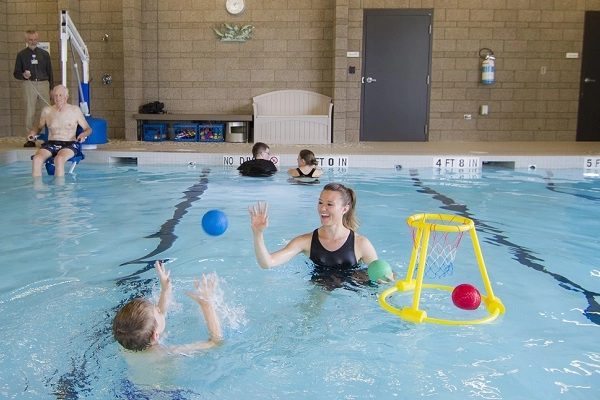Aquatic therapy provides relief for all ages


By Dawn Melvin, physical therapist assistant at the Salem Health Rehabilitation Center
This is not your average swimming pool. Why? Because it has nothing to do with swimming.
The aquatic therapy pool opened this spring inside the new Salem Health Rehabilitation Center.
Soothing water
The water temperature of the therapy pool is set at toasty 93 degrees — well above the average 75- to 80-degree range for traditional swimming pools.
The warmer water helps people with a wide range of issues, including everything from arthritis and other pain symptoms to recovering from knee and hip replacements or back surgery.
Many of our clients come here after their doctor determines that aquatic therapy would enhance their recovery. They have ranged in age from 4 months old to 98 years old.
Less gravity, more resistance
The buoyancy of the human body in water helps reduce the strain that gravity puts on our joints compared to on land. The water also helps to support you.
The water increases the resistance for movement. Many clients are surprised how challenging it is to walk in water with good posture. It’s also challenging to keep your balance and stabilize yourself while moving in water.
The ultimate surprise appears for many people when they get out of the pool after a therapy session. It might take some time for them to get used to the full force of gravity.
Some may also feel like they’re not doing anything strenuous while exercising in the pool. But they’ll likely feel sore later at home.
We constantly monitor how people are doing and make sure they’re not pushing through any pain while in the water.
Treatment schedule
The normal course for aquatic therapy is six to eight visits lasting between 30 and 45 minutes each.
After completing the full course, you may be able to continue on your own with the Swim Therapy Advanced Rehabilitation (STAR) program. A doctor’s order is required and you must demonstrate that you can perform the exercise program on your own.
The rehabilitation center also offers group therapy in the warm water pool for pediatric patients.
Building confidence
Some people fear water, while others may feel hesitant to get in. The therapy pool is equipped with a handrail and a hydraulic lift for those needing extra assistance.
Once clients find out they can do the exercises, they can’t wait to come back. Most end up doing well.
Aquatic therapy ultimately simulates movements that are difficult to tackle on land. Exercising in water helps people regain the strength confidence to return to previous activities — and leave the pain behind.